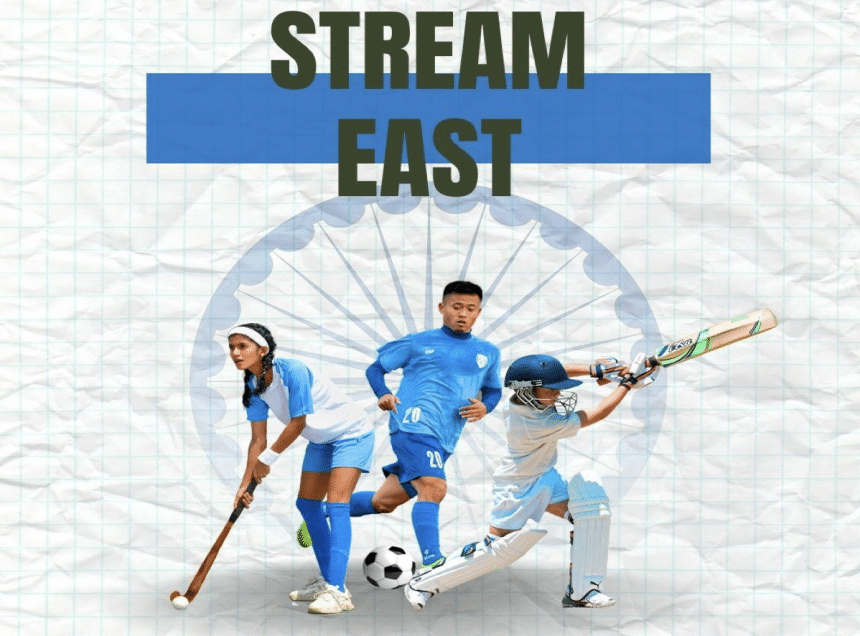StreamEast is a prominent player in the increasingly competitive realm of online sports streaming platforms. Designed to cater to a broad audience of sports enthusiasts, StreamEast offers a user-friendly, accessible solution for watching a variety of live sports events without the constraints of traditional cable TV subscriptions. As more viewers turn to the internet for their sports entertainment, platforms like StreamEast have grown in popularity due to their cost-effective approach and wide range of content offerings.
StreamEast as a Streaming Platform
StreamEast operates primarily as a free streaming service, which differentiates it from subscription-based platforms. It provides live streaming of sports events across multiple disciplines, making it a popular choice among viewers who wish to bypass the hefty fees associated with cable or premium streaming services. The platform is known for its broad coverage, which includes not only mainstream sports like basketball and soccer but also less commonly streamed sports such as handball and table tennis.

Services Offered by StreamEast
1. Live Sports Streams
- Major Sports Coverage: StreamEast offers live streaming of popular sports, including but not limited to, football, basketball, baseball, and hockey. This ensures that fans of major leagues such as the NFL, NBA, MLB, and NHL can catch live action as it happens.
- International and Niche Sports: Beyond the major leagues, the platform also covers international sports events and niche markets, providing streams for sports like cricket, rugby, and even esports.
2. Multi-View Streaming
- A distinctive feature of StreamEast is its multi-view capability, allowing users to watch multiple games simultaneously. This feature is especially appreciated by fans who wish to follow several matches or events that overlap in scheduling.
3. HD Streaming Quality
- Despite being a free service, StreamEast does not compromise much on the quality of its streams, offering HD quality where available. This is contingent on the user’s internet bandwidth but provides a clear, enjoyable viewing experience when conditions are optimal.
4. Interactive Features
- Chat Rooms: StreamEast enhances the viewing experience by integrating chat rooms alongside live streams, where fans can discuss the game in real-time, share thoughts, and engage with a community of viewers.
- Game Schedules and Notifications: The platform also offers comprehensive game schedules and can send notifications to keep users informed about upcoming games or important sports events.
5. Accessibility Across Devices
- StreamEast is available across a range of devices—desktops, laptops, smartphones, and tablets. This multi-platform accessibility allows users to enjoy their favorite sports streams from anywhere, on any device.
StreamEast stands out as a versatile and appealing option for fans looking to access a wide range of sports content without the financial burden of traditional sports media. The platform’s blend of extensive sports coverage, user-friendly features, and accessibility makes it a significant entity in the world of free online sports streaming.
How StreamEast Works
StreamEast operates by streaming live sports events through a web-based platform, leveraging various technologies to deliver content efficiently to users worldwide. Understanding how StreamEast works involves looking at the streaming technology it utilizes, the server setup, and the content delivery process that ensures viewers can watch live sports with minimal delay and high-quality resolution.
Technical Breakdown of Streaming Technology Used by StreamEast
1. Streaming Protocols:
- StreamEast probably employs widely-used streaming protocols like HLS (HTTP Live Streaming) or MPEG-DASH, which are crafted to deliver high-quality video content over the internet. For example, HLS operates by dividing the stream into a series of small HTTP-based file downloads, each representing a short segment of a potentially infinite transport stream.
- The use of adaptive bitrate streaming is also crucial. This technology allows the stream quality to adjust automatically based on the user’s internet speed, thus minimizing buffering and ensuring a smoother viewing experience.
2. Content Compression:
- To efficiently transmit video over the internet, StreamEast compresses video files using codecs like H.264 or H.265. These codecs are highly efficient at reducing the size of video files while maintaining quality, which is essential for delivering live sports streams that require real-time speed and clarity.
Server Setup and Content Delivery Process
1. Server Infrastructure:
- Content Distribution Network (CDN): StreamEast likely employs a CDN to distribute the streaming content to users around the world. CDNs reduce the distance between the server and the user, which decreases latency and buffering times. This is especially important for live sports events, where even a small delay can significantly impact the viewing experience.
- Load Balancing: To manage the high volume of users especially during popular sports events, StreamEast probably uses load balancing techniques. This involves distributing user requests across multiple servers to ensure no single server bears too much load, which can prevent server crashes and slow performance.
2. Content Management:
- Source Acquisition: StreamEast needs to acquire live sports feeds from various sources. These might include direct feeds from stadiums or arenas (less likely due to legal restrictions) or more commonly, through intermediaries that aggregate sports broadcasts.
- Real-Time Encoding and Transcoding: Once the content is acquired, it is encoded in real-time to make it suitable for streaming over the internet. This process also involves transcoding, where the original feed is converted into various formats and qualities to support different devices and bandwidth conditions.
3. Security Measures:
- Although security might not be the top priority for unofficial streaming sites like StreamEast, some basic forms of security, such as SSL encryption for the website, are likely in place. This helps protect user data during interactions with the site, such as when logging in or participating in chat rooms.
4. User Interface and Accessibility:
- The platform is designed to be accessible on multiple devices without the need for specialized software. This is achieved through a responsive web design that adapts to the screen size and capabilities of various devices, from smartphones to desktop computers.
The operation of StreamEast involves a complex array of streaming technologies and server infrastructures designed to deliver live sports content globally with efficiency and speed. While the legal and ethical considerations of using such a service remain debatable, the technical prowess behind its streaming capabilities is undeniably sophisticated, catering to the demands of sports fans seeking real-time access to events worldwide.
StreamEast User Experience
The user experience (UX) on StreamEast is a critical aspect of its popularity and usability. From the interface and navigation to the quality of streaming and community features, each element plays a vital role in how viewers interact with the platform. Here’s an in-depth review of these features:
User Interface and Navigation
1. Design and Layout:
- StreamEast typically features a straightforward, minimalist design that focuses on functionality over aesthetic flair. The home page usually displays a list of live sports events available for streaming, categorized by sport to simplify user selection.
- Navigation is designed to be intuitive, with a top menu for major sports categories and a search function that helps users quickly find specific games or teams.
2. Ease of Use:
- The platform is geared towards ease of use, with clearly marked sections and simple dropdown menus. This user-centric design ensures that even users with minimal technical skills can navigate the site without confusion.
- Accessibility features, such as adjustable text sizes and contrast settings, are not typically a focus on such platforms but can significantly enhance user experience if implemented.
Quality of Streaming
1. Video Quality:
- StreamEast aims to provide high-quality video streaming, often in HD resolution, depending on the source material. The actual video quality can vary based on the user’s internet connection and the platform’s server load at the time.
- Adaptive bitrate streaming is often employed to automatically adjust the video quality in response to the available bandwidth, ensuring the best possible viewing experience under varying internet speeds.
2. Buffering and Latency:
- Buffering issues can occur, especially during high-traffic events like major sports playoffs or finals. However, StreamEast likely uses server technologies and a content delivery network to minimize these issues.
- Latency is generally low, which is crucial for live sports streaming to ensure that the action is as close to real-time as possible.
Community Features
1. Chat Rooms:
One of the distinctive features of StreamEast is the inclusion of chat rooms alongside live streams. These chat rooms allow fans to interact during the event, share opinions, and engage in discussions, enhancing the communal viewing experience.
Moderation in these chats can vary, and the quality of discourse can fluctuate depending on the event and the participants.
2. Forums and Social Interaction:
- Some versions of the platform may offer forums where users can post more extended discussions, share content related to the sports they follow, and engage in off-topic conversations.
- These forums help build a community around the platform, though the level of activity and moderation can significantly affect the user experience.
The overall user experience on StreamEast is shaped by a combination of user-friendly interface design, generally reliable streaming quality, and engaging community features. While there are areas where improvements could enhance the experience further, such as more robust moderation in community spaces and enhanced accessibility features, the platform effectively meets the basic needs of sports fans looking for a straightforward and enjoyable streaming experience.
Comparison with Official Streaming Services
StreamEast provides an unofficial alternative to accessing live sports content, which can be contrasted with official, legal streaming services like ESPN+, DAZN, and others. Here’s a detailed comparison focusing on various factors:
Cost-Benefit Analysis
1. Cost:
- StreamEast: The main attraction is that it typically offers streams for free, which is particularly appealing to users unwilling or unable to pay for multiple sports subscriptions.
- Legal Services (ESPN+, DAZN, etc.): These services require a monthly or annual subscription fee, which can range from $5 to over $20 per month depending on the service and the package.
2. Quality and Reliability:
- StreamEast: While it often provides high-resolution streams, reliability can be an issue, particularly during high-demand events when servers may be overloaded, leading to buffering and lower quality.
- Legal Services: Offer high-definition streaming with more stable and reliable service, even during peak times, thanks to robust server infrastructure and optimized content delivery networks.
3. Legality and Security:
- StreamEast: Engaging with these streams involves legal risks as the service operates without content distribution rights, potentially exposing users to legal consequences. Security risks include exposure to malware through ads.
- Legal Services: Fully authorized and secure, eliminating legal risks and providing a safe environment free from malware and other security threats.
4. Content Access and Extras:
- StreamEast: Might not have access to all games or content, especially exclusive broadcasts.
- Legal Services: Provide comprehensive access to all games within the leagues they cover, including exclusive content, replays, highlights, and expert analysis, which are typically not available on free platforms.
Accessing StreamEast on Different Devices
1. PCs and Laptops:
- Accessing StreamEast on these devices is straightforward through web browsers like Chrome, Firefox, or Safari. The site is typically optimized for desktop use, providing a broader view and easier navigation.
2. Mobile and Tablets:
- While there’s no dedicated StreamEast app due to the platform’s unofficial nature, it can still be accessed on mobile devices via a web browser. The mobile version of the website is generally optimized for a smaller screen, with responsive design elements to ensure usability remains high.
- Limitations on mobile devices may include a more crowded interface and potentially more pronounced streaming issues, particularly on slower mobile networks.
3. Limitations and Optimizations:
- Optimizations: The site is likely designed to be responsive, ensuring that it adjusts to different screen sizes and resolutions. Streaming quality may adjust automatically based on the device’s internet capability.
- Limitations: On unofficial platforms like StreamEast, users might experience more variability in performance across different devices. The lack of an app might affect ease of access and user experience compared to official services that offer tailored apps for various platforms.
While StreamEast might seem appealing due to its no-cost access, the comparison with legal streaming services highlights significant benefits in terms of quality, reliability, and security when opting for services like ESPN+ or DAZN. These platforms not only ensure a high-quality viewing experience but also provide additional content and peace of mind regarding legality and data security, which are critical considerations for today’s digital consumers.
Future of Sports Streaming
The future of sports streaming is poised to undergo significant transformations driven by advancements in technology, shifts in consumer behavior, and evolving legal landscapes. Platforms like StreamEast, which operate in a somewhat grey area of content delivery, may face both challenges and opportunities as these dynamics play out.
Predictions on How Platforms Like StreamEast Might Evolve
1. Technological Enhancements:
- Increased Quality and Accessibility: As internet speeds and data handling technologies improve, platforms like StreamEast might offer higher quality streams, including 4K or even 8K resolutions, and more consistent streaming experiences with less buffering.
- Integration with Emerging Technologies: Augmented reality (AR) and virtual reality (VR) could be integrated to provide immersive viewing experiences, giving viewers the sensation of being at the game without leaving their homes.
2. Adaptation to Consumer Preferences:
- Customizable Viewing Options: Future streaming platforms might allow viewers to customize their viewing angles and choose which aspects of a game to focus on, akin to having control over camera positions.
- Interactive and Social Features: Enhanced interactive features such as in-stream betting, live chats, and integrated social media feeds could become standard to cater to a more engaged and interactive audience.
3. Business Model Innovation:
- Subscription Models: In response to potential crackdowns on illegal streaming, platforms like StreamEast might shift towards a subscription-based model, offering some content for free while reserving premium content for paid subscribers.
- Advertising and Sponsorship: Enhanced advertising models that are less intrusive but more personalized might be developed to increase revenue without degrading user experience.
Potential Changes in Laws and Technology Affecting Sports Streaming
1. Legal and Regulatory Developments:
- Stricter Copyright Enforcement: There could be stronger international cooperation and more robust technology to track and shut down unauthorized streams, compelling platforms like StreamEast to either legitimize or cease operations.
- Licensing Agreements: Changes in copyright laws might make it easier or necessary for platforms to obtain streaming rights, potentially leading these platforms to enter into official licensing agreements with sports leagues.
2. Technological Shifts:
- Blockchain and Rights Management: The use of blockchain technology could become prevalent in managing digital rights, making it easier to enforce copyright and licensing agreements securely and transparently.
- Advanced Content Delivery Networks (CDNs): Improvements in CDN technology might further reduce latency, making live sports streaming faster and more efficient, essentially eliminating the gap between live TV broadcasts and online streaming.
3. Consumer Data Protection:
- Enhanced Privacy Regulations: As consumer awareness and sensitivity towards data privacy increase, streaming platforms will need to adhere to stricter data protection standards, ensuring that user data is securely handled and privacy is maintained.
Conclusion
The future of sports streaming is likely to be marked by rapid technological advancements and significant shifts in legal frameworks. Platforms like StreamEast will need to navigate these changes carefully, adapting their business models and technologies to stay relevant and compliant within the new realities of digital content consumption. As these platforms evolve, they could potentially offer more personalized, immersive, and interactive streaming experiences, reshaping how fans engage with their favorite sports.












